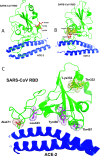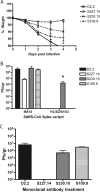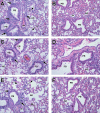Structural basis for potent cross-neutralizing human monoclonal antibody protection against lethal human and zoonotic severe acute respiratory syndrome coronavirus challenge
- PMID: 18199635
- PMCID: PMC2268459
- DOI: 10.1128/JVI.02377-07
Structural basis for potent cross-neutralizing human monoclonal antibody protection against lethal human and zoonotic severe acute respiratory syndrome coronavirus challenge
Abstract
Severe acute respiratory syndrome coronavirus (SARS-CoV) emerged in 2002, and detailed phylogenetic and epidemiological analyses have suggested that it originated from animals. The spike (S) glycoprotein has been identified as a major component of protective immunity, and 23 different amino acid changes were noted during the expanding epidemic. Using a panel of SARS-CoV recombinants bearing the S glycoproteins from isolates representing the zoonotic and human early, middle, and late phases of the epidemic, we identified 23 monoclonal antibodies (MAbs) with neutralizing activity against one or multiple SARS-CoV spike variants and determined the presence of at least six distinct neutralizing profiles in the SARS-CoV S glycoprotein. Four of these MAbs showed cross-neutralizing activity against all human and zoonotic S variants in vitro, and at least three of these were mapped in distinct epitopes using escape mutants, structure analyses, and competition assays. These three MAbs (S109.8, S227.14, and S230.15) were tested for use in passive vaccination studies using lethal SARS-CoV challenge models for young and senescent mice with four different homologous and heterologous SARS-CoV S variants. Both S227.14 and S230.15 completely protected young and old mice from weight loss and virus replication in the lungs for all viruses tested, while S109.8 completely protected mice from weight loss and clinical signs in the presence of viral titers. We conclude that a single human MAb can confer broad protection against lethal challenge with multiple zoonotic and human SARS-CoV isolates, and we identify a robust cocktail formulation that targets distinct epitopes and minimizes the likely generation of escape mutants.
Figures








References
-
- Bakker, A. B., W. E. Marissen, R. A. Kramer, A. B. Rice, W. C. Weldon, M. Niezgoda, C. A. Hanlon, S. Thijsse, H. H. Backus, J. de Kruif, B. Dietzschold, C. E. Rupprecht, and J. Goudsmit. 2005. Novel human monoclonal antibody combination effectively neutralizing natural rabies virus variants and individual in vitro escape mutants. J. Virol. 799062-9068. - PMC - PubMed
-
- Chan, K. C., N. L. Tang, D. S. Hui, G. T. Chung, A. K. Wu, S. S. Chim, R. W. Chiu, N. Lee, K. W. Choi, Y. M. Sung, P. K. Chan, Y. K. Tong, S. T. Lai, W. C. Yu, O. Tsang, and Y. M. Lo. 2005. Absence of association between angiotensin converting enzyme polymorphism and development of adult respiratory distress syndrome in patients with severe acute respiratory syndrome: a case control study. BMC Infect. Dis. 526. - PMC - PubMed
Publication types
MeSH terms
Substances
Grants and funding
LinkOut - more resources
Full Text Sources
Other Literature Sources
Miscellaneous

